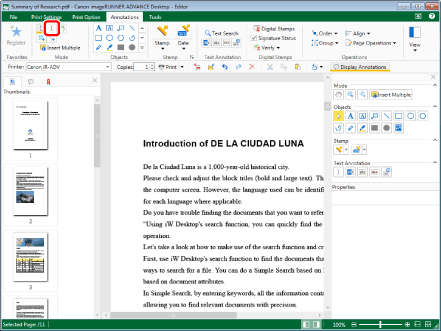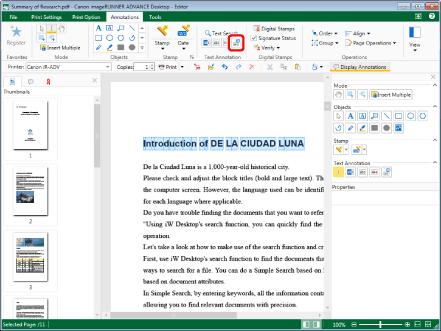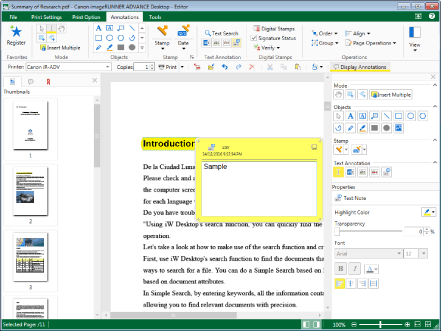Inserting Text Notes in Document Text
With Desktop Editor, you can insert a text note into a document as an annotation.
|
NOTE
|
 (Text Note) annotations have both highlighted text and notes that highlight text. (Text Note) annotations have both highlighted text and notes that highlight text.The note part of a text note is not printed.
|
Inserting New Text Notes
This section describes how to insert a text note into a document as a new annotation.
1.
Click  (Select Text) on the ribbon.
(Select Text) on the ribbon.
 (Select Text) on the ribbon.
(Select Text) on the ribbon.Or, follow one of the steps described below.
Click  (Text Note) on the ribbon.
(Text Note) on the ribbon.
 (Text Note) on the ribbon.
(Text Note) on the ribbon.Click  (Select Text) on the Details Window
(Select Text) on the Details Window
Click  (Text Note) on the Details Window
(Text Note) on the Details Window

|
NOTE
|
|
If the Details Window is not displayed, see the following.
This operation can also be performed with the tool buttons. If tool buttons are not displayed on the toolbar of Desktop Editor, see the following to display them.
You can also insert text notes multiple times. For more information, see the following.
|
2.
Drag the mouse pointer on the Work Window to select the string to insert the text note in.
When the cursor passes over a selectable text string, the shape of the mouse pointer changes to  .
.
If you clicked  (Select Text) in step 1, proceed to step 3.
(Select Text) in step 1, proceed to step 3.
 (Select Text) in step 1, proceed to step 3.
(Select Text) in step 1, proceed to step 3.If you clicked  (Text Note) in step 1, a text note is inserted in the text string, and text note properties are displayed on the Details Window. In this case, proceed to step 4.
(Text Note) in step 1, a text note is inserted in the text string, and text note properties are displayed on the Details Window. In this case, proceed to step 4.
 (Text Note) in step 1, a text note is inserted in the text string, and text note properties are displayed on the Details Window. In this case, proceed to step 4.
(Text Note) in step 1, a text note is inserted in the text string, and text note properties are displayed on the Details Window. In this case, proceed to step 4.|
NOTE
|
|
To cancel the insertion process, do one of the following.
Click
 (Select Object) on the ribbon (Select Object) on the ribbonClick
 (Select Text) on the ribbon (Select Text) on the ribbonClick
 (Grab Mode) on the ribbon (Grab Mode) on the ribbonClick the command selected on the ribbon again
Click
Click
Click
Click the selected button on the Details Window again
|
3.
Click  (Text Note) on the ribbon.
(Text Note) on the ribbon.
 (Text Note) on the ribbon.
(Text Note) on the ribbon.Or, follow one of the steps described below.
Click  (Text Note) on the Details Window
(Text Note) on the Details Window
Right-click and select [Text Note].

A text note is inserted into the text, and the text note properties are displayed on the Details Window.
|
NOTE
|
|
If the Details Window is not displayed, see the following.
This operation can also be performed with the tool buttons. If tool buttons are not displayed on the toolbar of Desktop Editor, see the following to display them.
|
4.
Enter text in the note.

|
NOTE
|
|
If there is no text entered into the note part,
|
5.
Select the range of text to set the properties for.
|
NOTE
|
|
To change the properties of an entire text note, select the border of the note area.
|
6.
Configure the properties of the text note.

|
[Highlight Color]
|
Select the highlight color you want to use from the list displayed when you click
|
|
[Transparency]
|
The slider position and the numeric value indicate the degree of transparency of the highlighted area of the text note. To change the degree of transparency, move the slider to the left or right, or enter a numeric value. You can also use
|
|
[Font]
|
Configure the font of text notes.
|
|
[Font]
|
Select the font to use from the list displayed when you click ▼. The list displays the fonts installed in your computer.
|
|
[Font Size]
|
Select the font size to use from the list displayed when you click ▼. You can also enter the font size directly. Font sizes that can be configured are between 3.0 points and 72.0 points. If it is entered directly, you can enter up to a single decimal place.
|
|
[Bold]
|
Makes the string bold.
|
|
[Italic]
|
Makes the string italic.
|
|
[Font Color]
|
Select the font color you want to use from the list displayed when you click
|
|
[Left]
|
Aligns the text to the left.
|
|
[Center]
|
Aligns the text in the center.
|
|
[Right]
|
Aligns the text to the right.
|
|
[Justify]
|
Justifies the text.
|
|
NOTE
|
|
If you select [More Colors] in [Highlight Color] or [Font Color], [Color] is displayed and you can set a color that is not listed in [Highlight Color] or [Font Color].
The settings in [Font] are only applied to the selected text. However, the following settings are applied on a line by line basis. They are applied to the line that includes the selected text or the line where the caret is displayed.
[Left]
[Center]
[Right]
[Justify]
Settings other than those in [Font] are applied to the entire annotation.
Properties can also be set from ribbon commands or tool buttons. For information on the commands and tool buttons that can set properties, see the following.
|
7.
Click on the Work Window outside the text note you inserted to deselect the text note.
When you deselect the text note, it is automatically closed.
|
NOTE
|
|
You can also close the text note by performing one of the following operations.
Click
Press the [Esc] key on the keyboard.
|
Changing Text Note Content
This section describes how to edit the content of a text note inserted into a document.
1.
Select the target text note in the Work Window.
|
NOTE
|
|
For more information on how to select an annotation, see the following.
|
2.
Click [Display Note] on the ribbon.
Or, follow one of the steps described below.
Right-click the text note to change the content of, and select [Display Note].
Double-click the text note to change the content of.

The note of the text note is displayed.
|
NOTE
|
|
If commands are not displayed on the ribbon of Desktop Editor, see the following to display them.
This operation can also be performed with the tool buttons. If tool buttons are not displayed on the toolbar of Desktop Editor, see the following to display them.
|
3.
Change the text in the note.
|
NOTE
|
|
If the text string is too long to fit in the note, a line break is automatically inserted.
|
4.
Click on the Work Window outside the note you edited to deselect the note.
When you deselect the text note, the changes made are automatically saved and the text note is closed.
|
NOTE
|
|
You can also close the text note by performing one of the following operations.
Click
Press the [Esc] key on the keyboard.
|